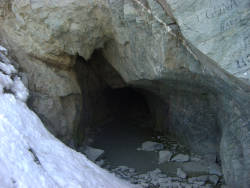Buco di Viso
Useful Information
| Location: |
5 km north of Monte Viso (Cottian Alps), between Crissolo and Ristolas.
From the Italian side: From Saluzzo SP260, SP117, SP26 to Crissolo, SP234 to the end of the valley, parking at Pian del Re. From the French side: From Abriès to Ristolas, D947/D9471 to the parking lot at the end of the road L’Echalp. (44.712211, 7.066527) |
| Open: |
no restrictions. [2021] |
| Fee: |
free. [2021] |
| Classification: |
 Subterranea Museum Subterranea Museum
|
| Light: |
 Incandescent Incandescent
|
| Dimension: | L=75 m, W=3 m, A=2,882 m asl. |
| Guided tours: | self guided |
| Photography: | allowed |
| Accessibility: | no |
| Bibliography: | |
| Address: | Buco di Viso, Tel: +39-0, Fax: +39-0, |
| As far as we know this information was accurate when it was published (see years in brackets), but may have changed since then. Please check rates and details directly with the companies in question if you need more recent info. |
|
History
| 1479 | works started. |
| 1480 | tunnel completed. |
| 1486 | Ludovico II Del Vasto escapes from Saluzzo to France through the tunnel. |
| 25-AUG-1907 | tunnel restored and reopened by the Torino Italian Alpine Club. |
| 1998 | tunnel restored by the Rotary Club of Saluzzo. |
| 2014 | tunnel restoration including major tunnel reinforcement. |
Description


The Buco di Viso (Monte Viso Tunnel) is one of the oldest traffic tunnels in the world, probably it is the oldest tunnel. The pedestrian tunnel was built during the Renaissance and is located high up at the mountain. It connects Italy and France, linking the villages of Crissolo in the modern Italian province of Cuneo and Ristolas in the French department of Hautes-Alpes. It was intended to increase trade by allowing the merchant caravans a less dangerous route across the Alps. As it was lower than the pass, it also increased the useful days for the passage as it avoided snow and bad weather of the higher section.
The man responsible for its creation was Marquis of Saluzzo Ludovico II Del Vasto. The House of Savoy threatened the autonomy of his marquisate, so he signed an agreement with King René of Anjou of the Kingdom of Naples. He was also the Count of Provence, and was therefore a vassal of the king of France Louis XI. The agreement was intended to increase trade, but the Alps were a massive geographical obstacle. The border followed the highest mountain ridge, there were few passes which allowed traffic across the border. And they were closed in winter due to snow and dangerous during bad weather. The pass Crissolo and Ristolas was reached across a slope of debris, but the highest point was a ridge of limestone cliffs.
The idea was to build a tunnel at the foot of the mountains avoiding this highest and most dangerous part. The agreement for its realization was sanctioned at Arles on September 22, 1478. The excavation works began in the next summer after the snow was gone. The work was interrupted during the winter and was completed at the end of the summer of 1480. The construction was directed by the engineers Martino di Albano and Baldassarre of Piasco. The total cost of 12,000 florins were paid by Ludovico II Del Vasto.
The increase in commercial traffic was immediate, and the Monte Viso Tunnel became a strategic route for the trade. The marquisate exported wine, rice, hemp and walnut oil, and imported fabrics, brocade, horses, and salt. The latter was the reason why the route was called salt route and more than 20,000 sacks of salt were transported this way every year. But the tunnel actually did not save Ludovico from the House of Savoy and finally he used the tunnel to escape to France.
The tunnel was of strategic importance for the military. In the Battle of Fornovo in 1495 the king of France Charles VIII deployed his army and artillery across the tunnel. In 1499 Louis XII, and in 1525 his successor François I, used the tunnel to fight against the Emperor Charles V in Italy. The tunnel and the trail were expanded to make them more viable to the artillery passage. But after the Treaty of Lyon (1601), the Marquisate of Saluzzo was annexed to the Duchy of Savoy. As a result the tunnel was closed permanently. Duke Carlo Emanuele I of Savoy had long-term rights on the Moncenisio and Monginevro valleys, so he preferred this route for goods because he earned taxes.
The tunnel was reopened on 25-AUG-1907 by the Torino Italian Alpine Club, funded by the Italian government, for touristic reasons. In 1998 the tunnel was cleared and reopened again by the Rotary Club of Saluzzo, information panels were erected at both entrances. The tunnel is a part of the network of mountain paths, but now and then it is still obstructed by rockfalls. The last renovation was in 2014 and included major tunnel reinforcement works.
The statement that this is the oldest tunnel seems weird. Since antiquity tunnels were built, which means there are tunnels which are 2,000 years older. However, the statement is that this is the oldest tunnel which was used for traffic. Tunnels were built for mining or as aqueducts to transport drinking water and sometimes sewage. But the idea to build a road through a mountain is rather young. Today its the opposite, almost any tunnel which is built is for a road or a railroad.
 Search DuckDuckGo for "Buco di Viso"
Search DuckDuckGo for "Buco di Viso" Google Earth Placemark
Google Earth Placemark Monte Viso Tunnel (visited: 15-OCT-2021)
Monte Viso Tunnel (visited: 15-OCT-2021) Index
Index Topics
Topics Hierarchical
Hierarchical Countries
Countries Maps
Maps